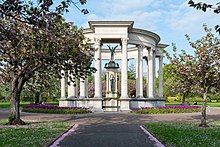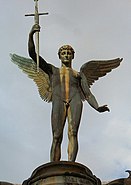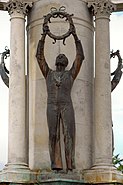Welsh National War Memorial
| Welsh National War Memorial | |
|---|---|
Cofeb Ryfel Genedlaethol Cymru | |
| Cardiff Council | |
 | |
| For Welsh soldiers who fought in World War I and World War II | |
| Unveiled | 12 June 1928 |
| Location | 51°29′12″N 3°10′49″W / 51.48658°N 3.18041°W |
| Designed by | Sir Ninian Comper |
Outer frieze I feibion Cymru a roddes eu bywyd dros eu gwlad yn Rhyfel MCMXIV–MCMXVIII[1] ('To the sons of Wales who gave their lives for their country in the war of 1914–1918') Inner frieze Remember here in peace those who in tumult of war by sea, on land, in air, for us and for our victory endureth unto death Above figures In hoc signo vinces | |
Listed Building – Grade II* | |
| Official name | Welsh National War Memorial [2] |
| Designated | 25 January 1966[2] |
| Reference no. | 13742[2] |
The Welsh National War Memorial (
Design and construction
The Memorial was first suggested in 1917.
The memorial takes the form of a circular colonnade surrounding a sunken court. On the frieze above the columns are inscriptions in Welsh, on the outer side, and in English, on the inner side. The English inscription was composed by Comper himself. At the centre of the court is a group of three bronze sculptures arranged around a stone pylon. Around the base stand three figures, a soldier, sailor and airman, holding wreaths aloft. There are appropriate inscriptions above the figures e.g. 'Over the sea he went to die', above the sailor. Above them, crowning the structure, is a winged male nude representing Victory.
The memorial's form was inspired by two visits to French North Africa and particularly
The memorial was unveiled on 12 June 1928 by
The Memorial is Grade II* listed.[2]
See also
Sources
- Anthony Symondson and Stephen Bucknall, Sir Ninian Comper (Reading: Spire Books, 2006)
References
- ^ Hammerton, John Alexander (1925), "Our War Memorials: II – The Great Cities and Some Others", Wonderful Britain: Its Highways Byways & Historic Places, vol. 3, retrieved 25 February 2017
- ^ National Historic Assets of Wales. Retrieved 12 May 2023.
- ^ a b c "Welsh National War Memorial". Public Monuments and Sculpture Association. Archived from the original on 2 February 2016. Retrieved 29 January 2016.
- ^ a b c "Welsh National War Memorial". Imperial War Museum. Retrieved 29 January 2016.
- ^ a b "Wales". BBC Hand Book 1929 (PDF). BBC. 1928. p. 95.
- ISSN 0033-8060.
External links
- Channel 4 Lost Generation Memorial Details
 Media related to Welsh National War Memorial at Wikimedia Commons
Media related to Welsh National War Memorial at Wikimedia Commons





